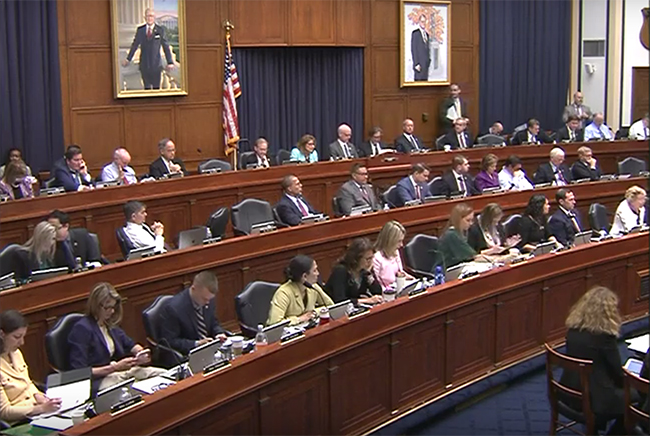
House Armed Services Committee legislators' disagreements on nuclear policy made themselves known during a June 12, 2019, markup of the 2020 defense policy bill. YouTube screenshot.
Partisan seams appeared during the House Armed Services Committee’s lengthy debate over whether to deploy a new low-yield nuclear warhead on submarines, putting members’ deeply held disagreements about nuclear policy on display. The discussion came during ??the full committee’s markup of the 2020 defense policy bill June 12.?
The House Armed Services strategic forces subcommittee’s mark of the 2020 defense policy bill seeks to withhold funds that would allow the Pentagon to deploy the W76-2, a low-yield warhead that proponents argue is needed to counter nuclear-armed adversaries. The 2018 Nuclear Posture Review recommended that warhead, which is seen as an option for shorter-range, tactical nuclear strikes from ballistic missiles on submarines, as well as a new sea-launched cruise missile.
Lawmakers sparred over, and ultimately vetoed,? amendments offered by Rep. Liz Cheney (R-Wyo.) that would allow the Navy to begin deploying the warheads and would fund the National Nuclear Security Administration to continue building them.
Democrats warned of tit-for-tat nuclear war, said the US’s conventional assets can already greatly damage Russia, and argued W76-2 deployment would set off a new arms race. HASC Chairman Rep. Adam Smith (D-Wash.) harkened back to “War Games,” the 1983 film in which a computer system learns the only way to win a nuclear war is not to engage.
Strategic forces subcommittee chairman Rep. Jim Cooper (D-Tenn.) noted the Air Force already flies smaller-scale nuclear bombs. If deployed, the W76-2 would be the first time nuclear submarines have been used for tactical purposes.
“The two primary risks you face if you deploy these so-called low-yield weapons on submarines are, one, you fire the weapon, the submarine is exposed,” Cooper said. “Two, there are a limited number of missile tubes, and to use one of these very precious tubes for a low-yield weapon is something we have never done before in all the decades that we’ve had nuclear weapons. So why risk the most survivable, the most precious leg of our triad with this actually fairly new idea?”
Republicans say Cold War-era strategies are outdated and that the nuclear arsenal should evolve to match modern threats. Deterrence only works if adversaries—such as the Russians targeting Eastern Europe—??believe the US would respond to their deployment of a low-yield weapon with similar capabilities, they argue. It makes more sense to counter low-yield strikes with other smaller weapons, rather than turn to high-yield missiles, Cheney said.
“To completely remove a weapons platform option for our armed forces throughout the world is nothing short of irresponsible,” Rep. Rob Wittman (R-Va.), ranking member on HASC’s seapower and projection forces subcommittee, said on Twitter. “If our adversaries are uncertain about where our submarines are and what warheads they are carrying, they will be deterred.”
Any provision to limit low-yield nuclear weapons will get pushback in the Republican-controlled Senate, which supports the program.
HASC is proposing several other nuclear-related provisions, including one to eliminate a requirement the Air Force opposes to build a conventional version of the Long-Range Standoff Weapon, a permanent ban on funding a mobile variant of new intercontinental ballistic missiles, and a request for a report on short- and long-term nuclear command, control, and communications plans.
The chairman’s mark proposes cutting Ground-Based Strategic Deterrent funding from $570.4 million to $489.4 million but fully funds the LRSO at $712.5 million and B-21 bomber development at $3 billion in 2020.
Republicans successfully stripped a part of the chairman’s mark that would have commissioned an independent, unclassified study on delaying the GBSD program and extending the life of Minuteman III intercontinental ballistic missiles to 2050.
?The committee had not voted on the bill by press time.